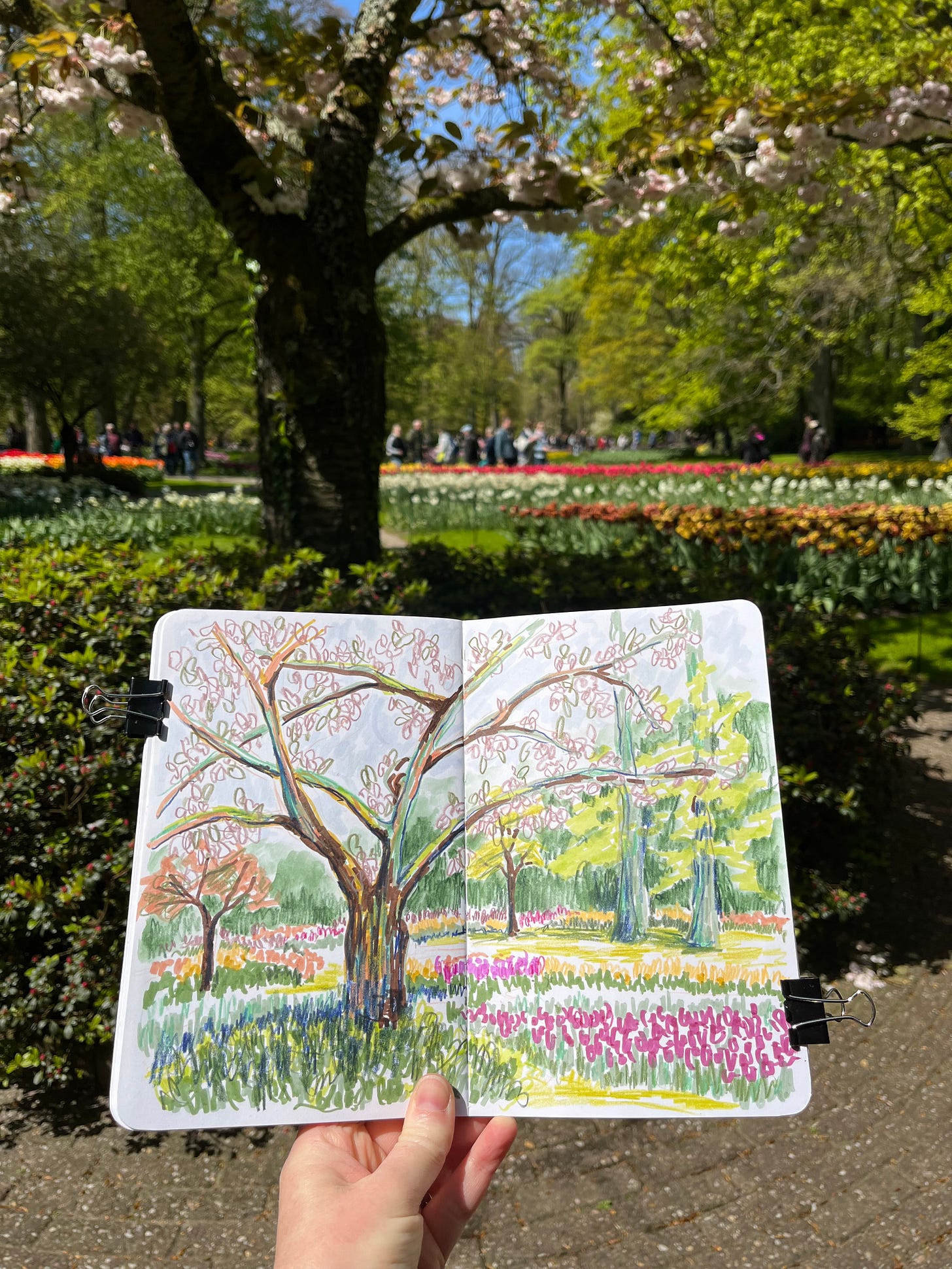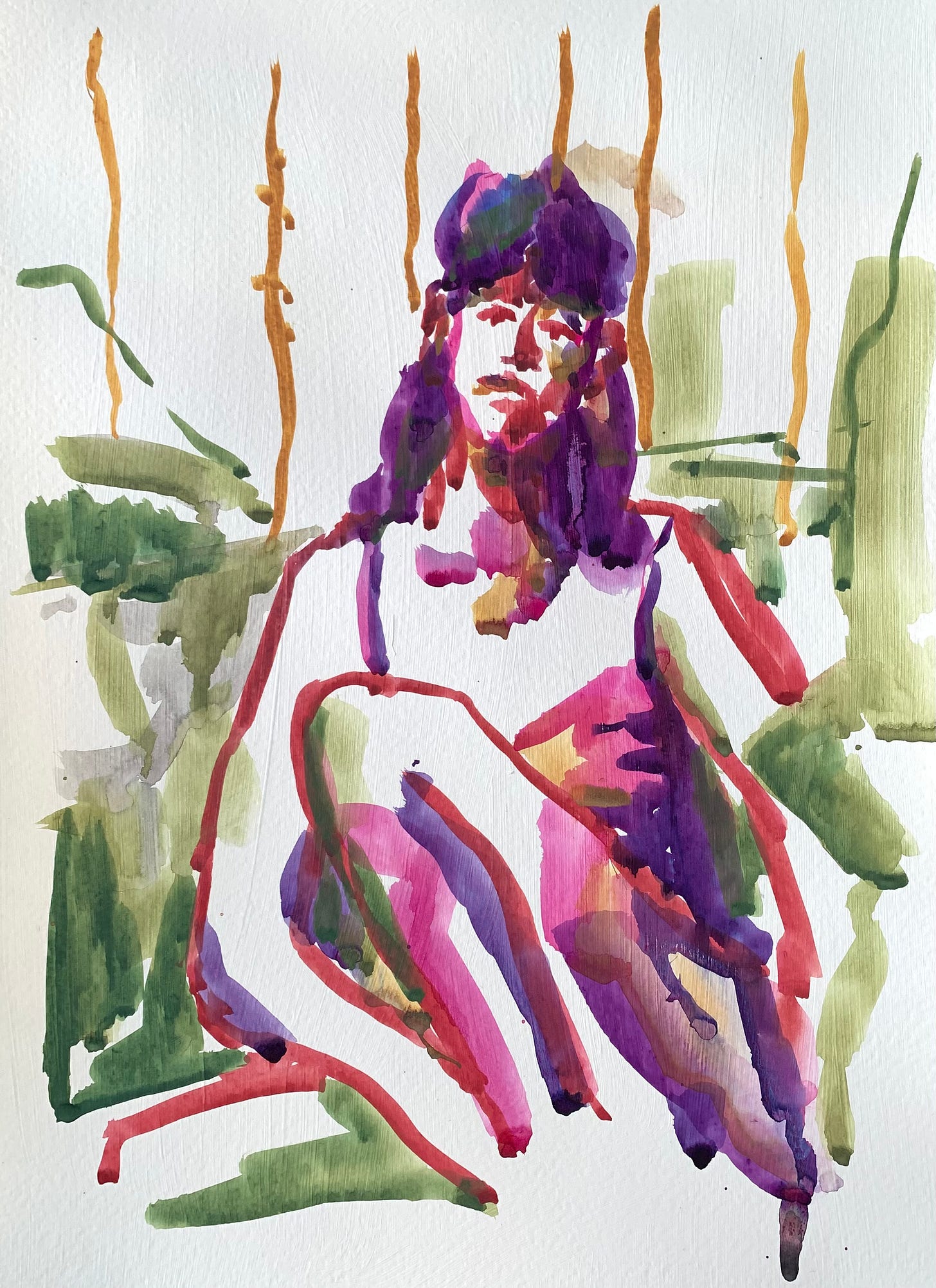What do pumpkins, tulips and watercolour paint have in common?
And it is probably not what you think.
Earlier this fall I went over to a friend’s house to fetch some tulip bulbs. Her bulb exporting husband brought home enough to plant a mini Keukenhof, so after she stuffed her garden full of them I was lucky enough to get some of the leftovers. Fall happens to be the perfect time of year for planting bulbs. This year, on the 5th of October the gardeners at Keukenhof started their 3 month process to plant a whopping 7 million flower bulbs, all by hand! During this last spring this, said friend and I went to sketch in Keukenhof. Seeing the beautiful end result of those three months of hard labour1 was totally worth sketching the landscape, even with droves of nosy tourists looking over one’s shoulders.
In the entrance hall of my friend’s house I was greeted by a heap of post Halloween pumpkins. She was trying to figure out what to do with all of them when I interrupted her, “Why don’t you cook them?”.
“But can you eat them?”
“Why not?”
“All of them?”
“I’m pretty sure you can.”
So after discussing all the things I managed to cook and bake with one huge €0,50 pumpkin during my student days, I left there with a back breaking heavy bag of flower bulbs and two pumpkins.
This exchange got me thinking about how easy and common it is to get stuck in our thinking about our art supplies. Let me use watercolour as an example. When I started with my watercolour journey, I watched quite a few watercolour tutorials online. And the idea was implanted in my mind that there was a specific, “correct” way to use them. That mainly being that you always have to work from light to dark and secondly that you always have to use an eye-roll amount of light washes to build up the painting over many hours and sometimes even days of waiting for the previous layer to dry. There was also a couple of no-no’s, cauliflower spots aka watercolour blooms being chief among them. If you want to, you can find an endless supply of youtube videos with titles like “Common mistakes every watercolour beginner makes” and “Don’t make these five watercolour mistakes.” I find the implication suffocating.
Luckily there isn’t only one, “correct” way to use watercolour. The same goes for all other art materials. I once came across some art made with cow dung in a well known museum. Surely if cow dung can be used to make art, watercolour blooms are also allowed?!
Early in 2022 I started experimenting with acrylic ink. Combining the skills that I have built up over the years using different materials, I started to make art that used a combination of line and colour shapes. It felt new and fresh. Later that year during a National Sketch Day, I decided to use that same technique, but since I only had watercolour on me, I decided to use that, and it worked just as well. No pen line with watercolour wash or endless hours of waiting for individual layers to dry. It suited my fast sketching tendencies and brought me so much joy in that moment. And do you know what the best thing is - I can still see the impact that that tangent of experimentation has on all my art, no matter what the medium.
Surely watercolour can also be used for line work and not only washes. Yes, the medium has it’s limits. Once you have gone too dark there is no coming back. But there are no watercolour police looking over your shoulder to make sure that you use it in only one, specific way, which all those youtube videos claim to be the only correct one. Do you know what the biggest mistake an artist can make is? Not making any art out of fear of making mistakes. It is well known that you miss 100% of the chances you don’t take.
So for this month’s sketchbook challenge, I challenge you to use an art medium in an unconventional way. Go and take some chances. Dare to experiment. Dare to explore.
To come full circle, I want to get back to those tulip bulbs. They too can be used in more ways than you would assume. During the winter of 1944 to 1945 there was a famine in the Netherlands. World War 2 was wreaking havoc in Europe, imports and exports weren’t happening and a months long freeze left the inhabitants of Amsterdam desperate. People were seeing their loved ones starve, so they turned to tulips and started to cook and eat the bulbs.2 Apparently the taste lies somewhere between an onion and a potato. I have never tasted them, but if push comes to shove, I know I have a whole mini-Keukenhof in my back yard that’s just waiting to bring me joy and a full belly.3
Thank you for faithfully reading Sketch. Explore. Create!, and thank you for all the kind and encouraging e-mails, messages and comments that I get after every edition. I hope that today’s edition once again inspired you to go out and create!
Anyone who has ever planted bulbs will know that it is back breaking work.
The tulip has quite an interesting history.
Please don’t go and eat your watercolour paints, alright?!








Thank you for this reminder!!!
So beautifully written! I appreciate this push into challenging myself to try something different, thank you.